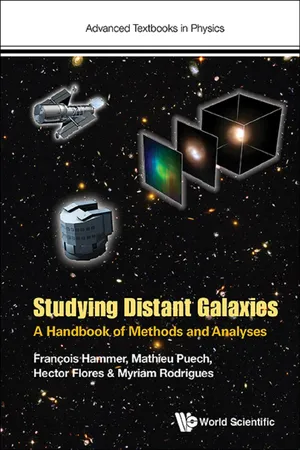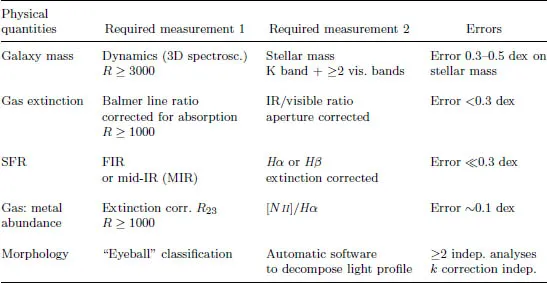
Studying Distant Galaxies
A Handbook of Methods and Analyses
- 400 pages
- English
- ePUB (mobile friendly)
- Available on iOS & Android
Studying Distant Galaxies
A Handbook of Methods and Analyses
About this book
-->
Distant galaxies encapsulate the various stages of galaxy evolution and formation from over 95% of the development of the universe. As early as twenty-five years ago, little was known about them, however since the first systematic survey was completed in the 1990s, increasing amounts of resources have been devoted to their discovery and research. This book summarises for the first time the numerous techniques used for observing, analysing, and understanding the evolution and formation of these distant galaxies.
In this rapidly expanding research field, this text is an every-day companion handbook for graduate students and active researchers. It provides guidelines in sample selection, imaging, integrated spectroscopy and 3D spectroscopy, which help to avoid the numerous pitfalls of observational and analysis techniques in use in extragalactic astronomy. It also paves the way for establishing relations between fundamental properties of distant galaxies. At each step, the reader is assisted with numerous practical examples and ready-to-use methodology to help understand and analyse research.
François Hammer worked initially in general relativity and made the first modelling of gravitational lenses prior to their spectroscopic confirmation. Following this, he became co-leader of the first complete survey of distant galaxies, the Canada–France–Redshift Survey. This led to the discovery of the strong decrease of the cosmic star formation density measured from UV light as z=1, which, alongside Hector Flores, they confirmed as bolometric and dust independent. With Mathieu Puech, they then pioneered the 3D spectroscopy of distant galaxies, leading to a major increase of understanding of the dynamic state of distant galaxies evidenced by the scatter of the Tully–Fisher relation. This led them to propose, with the addition to the team of Myriam Rodrigues, that galactic disks may survive or be rebuilt in gas-rich mergers, a scenario that is consistent with contemporary cosmological simulations. Besides extensive observational experience, the authors have led, or are leading, several instruments implemented or to be implemented at the largest telescopes, including VLT/Giraffe, VLT/X-shooter, VLT/MOONS and E-ELT/MOSAIC. They have also developed several observational techniques in adaptive optics, and in sky subtraction for integral field units and fibre instruments.
--> --> Contents: Samples and Selection Effects;Imaging;Spectroscopy;Spatially Resolved (3D) Spectroscopy;Determining Fundamental Quantities and Relations;
Readership: Professionals and students in the field of astrophysics and cosmology.
Astrophysics, Galaxies, Cosmology, Redshift, Surveys, Photometry, Spectroscopy0
Frequently asked questions
- Essential is ideal for learners and professionals who enjoy exploring a wide range of subjects. Access the Essential Library with 800,000+ trusted titles and best-sellers across business, personal growth, and the humanities. Includes unlimited reading time and Standard Read Aloud voice.
- Complete: Perfect for advanced learners and researchers needing full, unrestricted access. Unlock 1.4M+ books across hundreds of subjects, including academic and specialized titles. The Complete Plan also includes advanced features like Premium Read Aloud and Research Assistant.
Please note we cannot support devices running on iOS 13 and Android 7 or earlier. Learn more about using the app.
Information
Chapter 1
Samples and Selection Effects
1.1Introduction: which sample for which science goal?
1.1.1General rules to optimize the scientific returns from a survey of distant galaxies

1.2General rules for estimating magnitudes
1.2.1Monochromatic and integrated magnitudes



1.2.2Photometric systems
Table of contents
- Cover
- Halftitle
- Title
- Copyright
- Foreword
- List of Figures
- List of Tables
- List of Examples
- Glossary
- Introduction
- Contents
- 1. Samples and Selection Effects
- 2. Imaging and Photometry
- 3. Integrated Spectroscopy
- 4. Integral Field Spectroscopy
- 5. Applications and Scaling Relations
- Appendix A Most intense emission and absorption lines
- Index